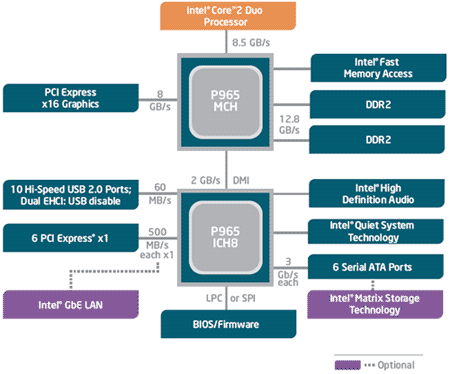Intel P965 Showdown - Abit vs. GIGABYTE
When Intel unleashed the Core 2 back in July, they introduced the P965 as their mainstream chipset, while the 975X Express chipset was upgraded with Core 2 support to cover the high-end enthusiast segment. However, the P965 didn't end up being 'just' a mainstream product. As production boards utilizing the P965 chipset began to appear in droves, the enthusiast crowd quickly realized that it was more than just a mid-range chipset when it came to performance. Several manufacturers also took the initiative and beefed up their P965 boards with impressive feature sets that exceed those found on some high-end 975X Express boards.
Today we will be evaluating two performance oriented P965 boards from two companies that have traditionally occupied very different market positions. Gigabyte's GA-965P-DQ6 and Abit's AB9 Pro are both aimed squarely at the enthusiast crowd. These two companies with wildly different pasts are now vying for the same piece of the enthusiast pie, but from different ends. Gigabyte is coming from the high-end with the DQ6, packed with features galore, while Abit is coming from the budget segment with the AB9 Pro, a no-nonsense overclocker.
Before we get down to the business at hand, lets take a quick tour of the P965 chipset and see exactly what sets it apart from the familiar 975X Express.

Intel P965 Chipset Overview
The first, and most obvious difference between the P965 and its older brother is price. P965 boards can be found occupying the mid-$100 price range. Cheaper boards can be found for as low as $100 and some of the more fully featured P965 boards break the $200 mark. 975X Express boards, on the other hand, start at $150 and can cost as much as $300. The two boards we are looking at today occupy the P965's mid to upper price range.
While the 975X Express technically has superior PCI Express support, the P965 boasts several features not found on the 975X, as well as a significantly lower price tag. The most notable addition, when it comes to performance, is official support for DDR2-800. While the 975X officially supported DDR2-667 initially (later revisions added DDR2-800 support), the P965's memory controller was designed to handle DDR2 memory running at speeds up to 800MHz out of the gate. This gives the P965 a 2.1GB/sec theoretical memory bandwidth advantage over the 975X when the latter is running at DDR2-667 speeds. DDR2-800 gives the P965 a theoretical peak memory bandwidth of 12.8GB/sec.
The most dramatic difference between the P965 and its older brother is in its South Bridge. The P965 boasts the brand new ICH8 South Bridge while the 975X utilizes Intel's older ICH7. The ICH8 is all about more features. Where the ICH7 supported four SATA drives, the ICH8 supports six. While the ICH7 supported eight USB 2.0 ports, the ICH8 supports ten.
Another difference between the ICH8 and its older sibling is the focus on serial ATA support. In fact, parallel ATA support is missing from the ICH8 altogether. Starting with the ICH6, Intel has been trying to de-emphasize PATA. Unfortunately, optical drive manufacturers have not been very keen on using SATA and PATA is still found on the vast majority of optical drives. Most manufacturers include a third-party PATA controller on their P965 boards to remedy this issue.
While the P965 tops the 975X in several areas, there is one troubling fault that will plague some enthusiasts. As previously mentioned, the P965 lacks in the multi-GPU department. Until recently, those of us who wanted Crossfire support had to stick with the older 975X chipset. This was because the P965 specification doesn't include support for several features essential to the operation of a Crossfire setup. With the release of Catalyst 6.9, it is now possible to run a Crossfire setup on a P965 board with two PXCI-E x16 slots by using the Crossfire dongle. However, a Crossfire capable BIOS is required for the P965 board and current manufacturer support is spotty. As some early reports reveal, even if you do manage to get Crossfire to work on a P965 board, it currently only works in Direct3D applications and the performance still isn't quiet up to par with a similar setup on a 975X board.
Overall, the P965 and 975X Express chipsets are very similar. The two also perform similarly, except when it comes to Crossfire. However, word is that Catalyst 6.10 will close the performance gap and add OpenGL support, turning the P965 into a Crossfire-ready solution. But for the time being Crossfire is still primarily in the 975X's realm and the 975X's main advantage over the P965. Even with that advantage it's not hard to see that the P965 is a great value. If P965 gets comparable Crossfire support, there won't be much reason to fork over the extra $50-$100 for a 975X Express board at all.






